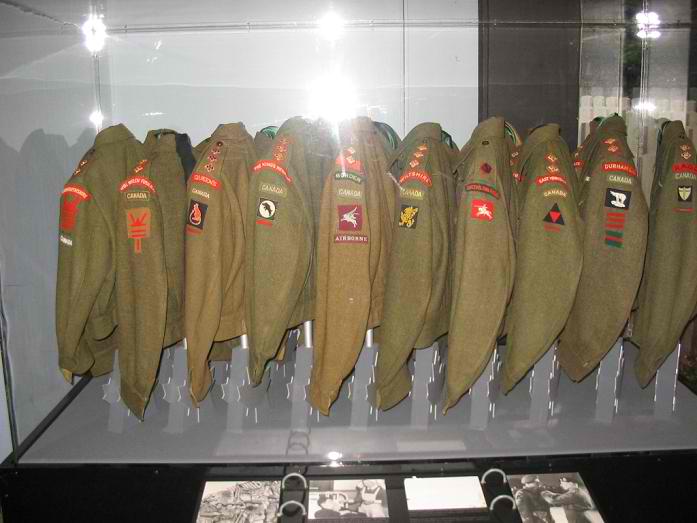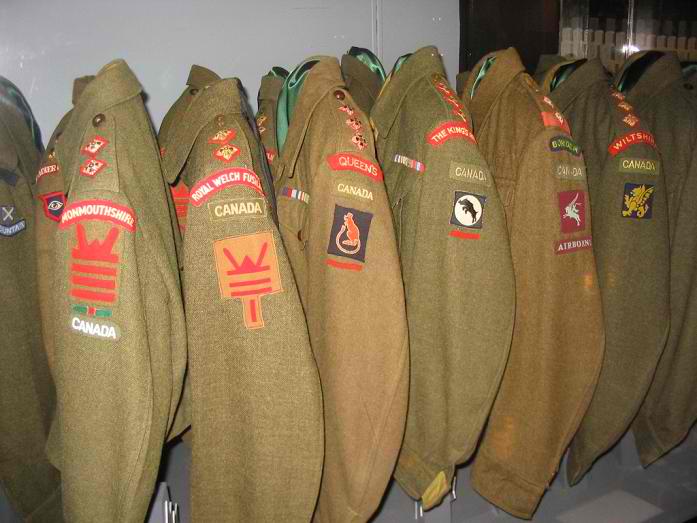I think these are two of the rarest BD's:
Force 136 (SOE, Chinese Canadians) BD
1st Canadian Armoured Carrier Regiment BD


Bill wrote:Plus, the unit was disbanded, and the Canadian personnel re-assigned. So, the tunic would have to be one for a fellow who came home instead of going into the reinforcement stream.
I will still vote with the PEILH. Being a company/squadron in strenght, there were very few to start with, and I have only ever seen one on the market.









Battalion Colours wrote:Yes Roy, Vic Taboika had an impressive WW II collection.
Bill wrote:Some observations. Second World War tunics have been the subject of "mythologizing" of recent. Ebay and auction listings and some vendors repeatedly say "D-Day" tunic, or "front line tunic", or "salty" (implying wear at the front) etc. This is basically bunk. Front line tunics were withdrawn and destroyed or ragged. They were dirty, damaged, or contaminated. For health reasons, a lesson learned from the FWW, the tunics were frequently replaced. So the tunics that we see are (with the rare exception) the tunics the soldiers came home with. And these were relatively newly issued. The date stamp was/is somewhat irrelevant. A 1942 tunic may have been in stores for months, maybe even longer before being issued. Or the soldier may have taken his 1940 issue BD and have had it dressed up as his best "parade" BD. But, soldiers had two tunics, one his best BD, and a working BD. Best BD were reserved for special parades and leave. They were stored in the soldier's kit bag when the unit went into front line service. It seems the working BD have become the "at the Front" tunics. Because they show some wear and tear, they "must have been in the field". Well, yes, BUT, even after the war ended, soldiers still trained, had fatigue duties, work parties etc, etc. These tunics would show everyday use. That doesn't mean fighting service.
Prices have spiralled upwards very quickly, but SWW Canadian tunics should be carefully analyzed before laying out any money. These tunics are really only the sum of the parts, yet some collectors have been pushing these tunics to amazing prices. On top of this, a spate of re-constructed tunics have made their way on the market. Some are obviously reconstructions, others are very difficult to spot. If one is to put out a lot of money on a SWW tunic, it would be prudent to have an iron clad provenance.
For example, I have a mint 1944 dated battle dress blouse in my closet, and I have a many printed and embroidered titles and formation patches in my traders. If I wanted I could easily put together an "authentically" patched tunic to any number of Canadian SWW units. So, why is it that a Linc & Winks 4 CAD tunic is worth $400, while the component parts are only worth about $100???
An additional consideration. There was a large home defence force which consisted of regiments which only served in Canada, and also 3rd Bns of regiments which had a battalion serving overseas. The home defence bn's were entitled to wear coloured embroidered titles. It is possible to find Black Watch, Queen's Own Rifles, Regina Rifles and other regiments, with patched tunics that represented home defence service. They all had battalions that only served in Canada. These tunics may not have had formation patches. (There is currently a QOR SWW era tunic on ebay. No formation patches. So, is it a 3 CID tunic, or a home defence tunic?) Regimental dress was the same, either in Canada or overseas. Sorry for the rant, but it seems a lot of collecting is not based on research or understanding the artifacts that are made available. Greed, fraud and mis-representation have become far too common.
Back to rarity. Another contender for the home forces scare tunics would be any tunic patched to either No 1 or No 2 Canadian Army Course. No 1 would be far scarcer, as it was only about 1/10th the enrolment of No 2.



Bill wrote:Some observations. Second World War tunics have been the subject of "mythologizing" of recent. Ebay and auction listings and some vendors repeatedly say "D-Day" tunic, or "front line tunic", or "salty" (implying wear at the front) etc. This is basically bunk. Front line tunics were withdrawn and destroyed or ragged. They were dirty, damaged, or contaminated. For health reasons, a lesson learned from the FWW, the tunics were frequently replaced. So the tunics that we see are (with the rare exception) the tunics the soldiers came home with. And these were relatively newly issued. The date stamp was/is somewhat irrelevant. A 1942 tunic may have been in stores for months, maybe even longer before being issued. Or the soldier may have taken his 1940 issue BD and have had it dressed up as his best "parade" BD. But, soldiers had two tunics, one his best BD, and a working BD. Best BD were reserved for special parades and leave. They were stored in the soldier's kit bag when the unit went into front line service. It seems the working BD have become the "at the Front" tunics. Because they show some wear and tear, they "must have been in the field". Well, yes, BUT, even after the war ended, soldiers still trained, had fatigue duties, work parties etc, etc. These tunics would show everyday use. That doesn't mean fighting service.
Prices have spiralled upwards very quickly, but SWW Canadian tunics should be carefully analyzed before laying out any money. These tunics are really only the sum of the parts, yet some collectors have been pushing these tunics to amazing prices. On top of this, a spate of re-constructed tunics have made their way on the market. Some are obviously reconstructions, others are very difficult to spot. If one is to put out a lot of money on a SWW tunic, it would be prudent to have an iron clad provenance.
For example, I have a mint 1944 dated battle dress blouse in my closet, and I have a many printed and embroidered titles and formation patches in my traders. If I wanted I could easily put together an "authentically" patched tunic to any number of Canadian SWW units. So, why is it that a Linc & Winks 4 CAD tunic is worth $400, while the component parts are only worth about $100???
An additional consideration. There was a large home defence force which consisted of regiments which only served in Canada, and also 3rd Bns of regiments which had a battalion serving overseas. The home defence bn's were entitled to wear coloured embroidered titles. It is possible to find Black Watch, Queen's Own Rifles, Regina Rifles and other regiments, with patched tunics that represented home defence service. They all had battalions that only served in Canada. These tunics may not have had formation patches. (There is currently a QOR SWW era tunic on ebay. No formation patches. So, is it a 3 CID tunic, or a home defence tunic?) Regimental dress was the same, either in Canada or overseas. Sorry for the rant, but it seems a lot of collecting is not based on research or understanding the artifacts that are made available. Greed, fraud and mis-representation have become far too common.
Back to rarity. Another contender for the home forces scare tunics would be any tunic patched to either No 1 or No 2 Canadian Army Course. No 1 would be far scarcer, as it was only about 1/10th the enrolment of No 2.









 Canadian WWII BD
Canadian WWII BD WWII Canadian BD
WWII Canadian BD